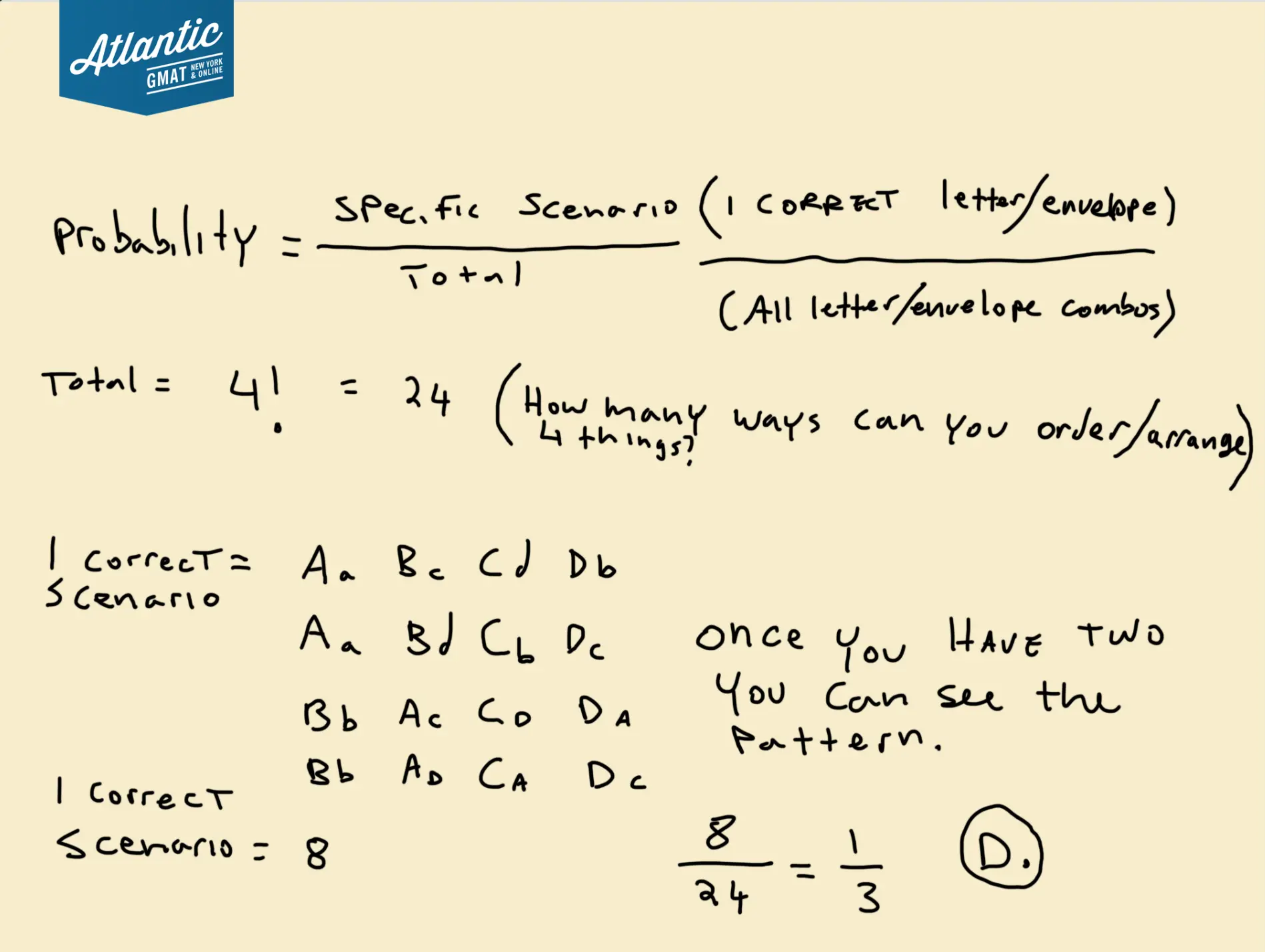A. 1/24
B. 1/8
C. 1/4
D. 1/3
E. 3/8
Good old Tanya’s letters!
The first time I saw this question it stumped me. Mostly because I took to long to solve it by trying to be overly math-y and complicated. Here’s a quick reminder to: stay practical!
There are no awards for elegance
As a GMAT tutor it’s tempting to rely on fancy pants GMAT strategies (what messed me up on “Tanya’s letters”) but this test is about nuts and bolts critical thinking. Keep that in mind during your entire GMAT prep.
Keep it simple. Stay grounded. Internalize strategies and principles that resonate with you. That really make sense.
Ok, here we go.
This is from the GMAT Prep Tests 1 and 2 so if you haven’t tackled those then hold off on working through this.
Let’s start with the entire solution worked out and then you’ll find a detailed step by step and rationale below!
Table of Contents
Tanya and her letters
This is a tricky GMAT combinatorics probability question that has a somewhat simple solution. And that’s something that you need to keep in mind on the GMAT. Not everything is about elegance. Or math power. Or some trick or strategy. A lot of your success on the GMAT will rely on making step by step, organized, practical choices. Not all combinatorics questions need to be tackled with factorials or the slot method.
Some questions are best solved by writing out scenarios and/or spotting a pattern. Tanya and her letters is one such question. It can be solved purely with combinatorics formulas but most people will probably be more successful at least doing part of this one with a more practical approach.
So what’s a sign for: don’t cram it into a formula and stay practical! The biggest sign, there aren’t that many possibilities. So writing it out wouldn’t be a big time suck (there are only 4 envelopes and 4 letters). Secondarily, if the setup feels non-standard or has a bunch of moving parts that don’t fit well into a formula that might indicate that a more practical/non-math setup would make more sense.
Let’s start by defining the question
what is the probability that only 1 letter will be put into the envelope with its correct address?
OK – no problem. Probability doesn’t mean difficult. We need, Our Scenario/Total. So, only 1 letter will be put into the envelope with its correct address/Total possibilities.
Now go ahead and start setting things up/organizing information
Letters: A, B, C, D
Addresses/Envelopes: a, b, c, d (I used lowercase versions of the letters to make it easy to match up correct letters/addresses)
The total is usually the easiest thing to figure out because you likely won’t have any constraints that could make the setup trickier. In this case we have 4 options for letters and 4 options for addresses. So you have 4 spaces for letters (treat this as an ordering question). How many different ways can you arrange 4 things? 4! = 24.
Now we need to calculate the numerator which is the specific scenario: only 1 letter will be put into the envelope with its correct address
For this you might just write it out. It’s quick. You should see the pattern after the first two so you don’t have to write out the rest.
Aa Bd Cb Dc
Aa Bc Cd Db
Bb Ac Cd Da
Bb Ad Ca Dc
Cc Ab Bd Db
Cc Ad Bd Da
Dd Ac Ba Cb
Dd Ab Bc Ca
You can also do this with a formula which is neater but not necessarily faster or easier/less prone to error.
There are 4 correct matchups:
Aa
Bb
Cc
Dd
And then you need to figure out the remaining incorrect ones. So, let’s just take the first correct one Aa. For the next slot, b you have 2 options (c, d) but once you’ve chosen c or d you don’t have choices for the last two slots, you’re locked in, you only 1 option each because any other arrangement will create a “correct” address/letter combination.
So you have 4 correct options (Aa, Bb, Cc, Dd) and then 2 options for the incorrect ones. 4*2 = 8.
That’s not complicated but I see a lot of GMAT tutoring students get tangled up there. And considering you don’t have to write out much to see the pattern, a practical approach is usually more successful on this question.
Finally, let’s put it all together
8/24 = 1/3.
So 1/3 of the time you are left with only one of Tanya’s letters in the envelope with the correct address.
Correct Answer: D
More GMAT Combinatorics and Probability Questions!
Here’s a great one from the GMAT official guide that also touches on the idea of being practical with combinatorics: A researcher plans to identify each participant in a certain medical experiment
And another tough oddball combinatorics question from the GMAT Prep Tests: A certain office supply store stocks 2 sizes of self-stick notepads, each in 4 colors
And here are two tough official GMAT probability questions:
A basket contains 5 apples, of which 1 is spoiled and the rest are good.
And lastly here’s a challenging combinatorics/probability question from GMAT question of they day
Learn more about GMAT tutoring with Atlantic
GMAT Question of the Day Signup
Sign up for 1 challenging GMAT question sent to you each week.


